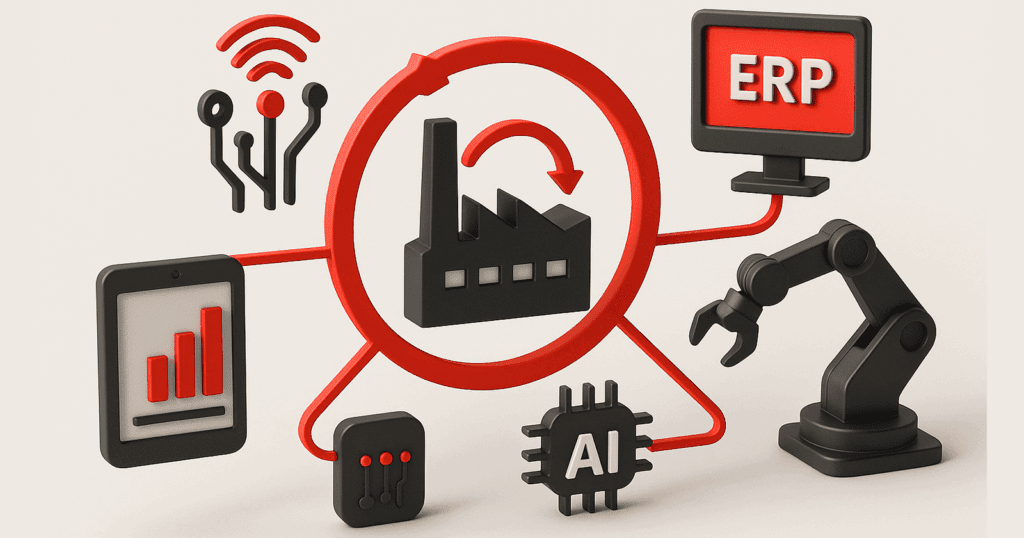Abstract
Digital manufacturing is redefining how companies structure, manage, and optimize their supply chains. As global disruptions, fluctuating demand, and increasingly complex logistics challenge traditional models, manufacturers are turning to digital solutions to boost efficiency and resilience.
This article explores how the digital supply chain in manufacturing is evolving through smart tools like digital twins, IIoT, AI, and PLM systems like the 3DEXPERIENCE platform—offering practical insights for businesses ready to streamline operations and sharpen their competitive edge.
Introduction: The New Era of Manufacturing Logistics
Traditional supply chains—often fragmented, opaque, and reactive—are no longer sustainable in a fast-moving global economy. Manufacturers are increasingly adopting digital strategies to anticipate disruptions, automate workflows, and enable end-to-end visibility. This transition is not just a technological upgrade—it’s a strategic shift that places the digital supply chain in manufacturing at the heart of operational excellence.
What Is a Digital Supply Chain?
A digital supply chain in manufacturing integrates digital technologies into every stage of the supply network—from procurement and production to warehousing and distribution. It leverages real-time data, intelligent automation, and seamless connectivity to:
- Improve traceability and visibility
- Enhance decision-making with predictive analytics
- Minimize waste and reduce costs
- Strengthen collaboration across departments and partners
Core Technologies Powering Digital Manufacturing Supply Chains
To understand the transformative potential of the digital supply chain, it’s essential to examine the technologies enabling this evolution:
IIoT connects machines, sensors, and software to collect real-time data. In manufacturing, this means tracking everything from equipment performance to shipment locations.
Benefit: Enhanced situational awareness and immediate response to anomalies.
- Digital Twins
Digital twins are virtual replicas of physical systems. They simulate supply chain behavior, enabling manufacturers to test “what-if” scenarios without disrupting actual operations.
Benefit: Risk-free planning and improved agility.
- Artificial Intelligence & Machine Learning
AI-driven analytics help predict demand, optimize inventory, and identify bottlenecks in production.
Benefit: Data-driven decision-making and reduced forecasting errors.
- Cloud-Based PLM and ERP
Product Lifecycle Management (PLM) and Enterprise Resource Planning (ERP) systems hosted on the cloud offer real-time updates and cross-functional collaboration.
Benefit: Centralized control and faster coordination between teams.
Expanding Efficiency Through Strategic Software Integration
Technology alone isn’t enough—true transformation comes from smart implementation. Comprehensive platforms available through trusted technology partners (like us!) now allow manufacturers to go beyond modular improvements and instead execute wide-scale, synchronized upgrades across their value chains.
Did you know? Mecanica offers full PLM consulting and implementation services. Check it out!
For instance, when manufacturers deploy scalable PLM suites that incorporate CAD data, regulatory compliance, BOM (Bill of Materials) management, and change tracking under one roof, cross-departmental confusion plummets. Production delays caused by communication breakdowns are significantly reduced, and the product development cycle becomes both faster and leaner.
Additionally, the integration of MES (Manufacturing Execution Systems) with ERP platforms creates a seamless bridge between the production floor and administrative oversight. Decisions once made through delayed reports can now be guided by real-time KPIs and alerts—empowering floor supervisors, operations managers, and logistics coordinators to act with confidence.
Remote collaboration also plays a pivotal role. Through cloud-hosted platforms like the 3DEXPERIENCE, dispersed engineering and supply chain teams can co-author designs, evaluate production constraints, and prepare contingency logistics—all from a shared digital workspace.
Beyond these enterprise-level tools, even small to mid-sized companies can benefit from modular, scalable solutions that offer a stepwise approach to digital maturity. From automated quality inspections to advanced simulation tools, these capabilities are no longer reserved for large global firms. Industry-specific bundles and tailored training programs make it feasible for growing manufacturers to compete with greater agility and foresight than ever before.
Benefits of a Digital Supply Chain in Manufacturing
Transitioning to a digital supply chain isn’t just about technology—it’s about measurable outcomes. Manufacturers adopting these solutions are seeing tangible benefits:
Enhanced Agility
Dynamic, data-driven supply chains respond faster to market changes and supply disruptions.
Cost Reduction
Automation and predictive tools cut operational costs by reducing downtime, overproduction, and excess inventory.
Sustainability Gains
Digital visibility helps identify inefficiencies and waste, aligning manufacturing with environmental goals.
Risk Mitigation
Early-warning systems, simulations, and scenario planning reduce exposure to global shocks like pandemics or geopolitical instability.
How Digital Manufacturing Solves Supply Chain Challenges
Consider a mid-size automotive supplier facing chronic delays in receiving parts and a limited ability to forecast demand. After implementing IIoT sensors across its assembly lines and adopting AI forecasting tools, the company saw noticeable improvements in operational responsiveness and customer delivery timelines. Their digital supply chain in manufacturing not only streamlined operations but also enabled stronger collaboration with upstream and downstream partners.
This kind of transformation isn’t limited to a single industry. From aerospace to consumer goods, companies leveraging digital infrastructure are experiencing smoother procurement processes, more accurate production planning, and greater resilience during disruptions. The ability to pivot quickly and transparently communicate status updates across the supply chain is becoming a baseline expectation from customers and partners alike.
Challenges to Implementation
While the benefits are compelling, transitioning to a digital supply chain comes with hurdles:
- Data silos that prevent end-to-end visibility
- Legacy systems that are incompatible with new tech
- High upfront investment for infrastructure upgrades
- Workforce resistance to new workflows and tools
Solutions include phased rollouts, change management programs, and choosing platforms with open APIs and low-code customization options.
Best Practices for a Successful Digital Transition
To fully realize the potential of the digital supply chain in manufacturing, companies should:
- Start with a clear strategy: Define your goals, KPIs, and target processes for digitalization.
- Prioritize integration: Choose platforms that easily connect with your existing ERP or MES.
- Train your workforce: Upskill employees to operate and maintain digital systems.
- Partner with Mecanica: Collaborate with our experts, who offer tailored support and strategic advice.
- Iterate and scale: Start with pilot programs and gradually extend them across the enterprise.
Conclusion: The Competitive Advantage of Going Digital
As complexity and uncertainty rise, the digital supply chain in manufacturing offers companies a lifeline—transforming reactive workflows into proactive strategies. Whether you’re looking to minimize risk, cut operational costs, or scale your global reach, the journey starts with smart tools and strategic implementation.
To find out how your business can implement cutting-edge digital manufacturing tools tailored to your needs, reach out to our experts at Mecanica today and take your supply chains to the next level.


